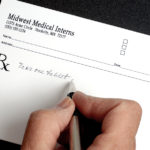Look-Alike, Sound-Alike: A Common Cause of Medication Errors

Pharmacy folks, like many others, turn to social media to express frustration with their job. One of the more common photos posted these days shows a prescription with a plea for help from the public to interpret the name of a prescription item … "what in the world is the name of this drug?" Answers may range from humorous to slightly off-color, but the overall consensus is that sometimes it's hard to be 100% sure. What is clear, however, is that handwriting and other factors often contribute to confusion around drug names that look and sound similar. These drugs are also known as "look-alike, sound-alike" medication pairs (LASA). When confusing labels are paired with a high stress work environment with many distractions, errors are bound to occur.
RELATED: 10 Errors of Computer-Generated Prescriptions You Should Be Aware Of
A study completed by the Food and Drug Administration (FDA) evaluated common causes of errors related to medication. This study found the most common type of fatal medication error was improper dose (41%), and the second most common type of error was related to wrong drug and wrong route of medication (16% each). It is clear that labeling is an important part of medication safety. How can pharmacy technicians play a role in reducing the risk of medication errors and minimize patient harm, particularly involving drug names?
The Prescription Label: It All Starts Here
The pharmacy technician is often the first staff member to receive and interpret the prescription label, and can pause the process if any information is missing or includes an error. For example, although not all states require the prescriber to list the purpose the patient is taking a medication (also known as the "indication"), inclusion of this information can serve as a "red flag" if the wrong medication has been chosen. Sometimes this information may simply be vague, such as "Take <blood pressure medication> for heart health", but other times the indication may be completely incorrect, such as "Take <cholesterol medication> for infection." These types of inconsistencies may require the pharmacist or another staff member to call the prescriber's office to clarify the prescription. If possible, the technician should also refer to the patient's medical record to confirm the prescription diagnosis matches a health condition included in the patient's chart. Any inconsistencies should be discussed with the supervising pharmacist immediately.
Safety Must Always Come First
Unfortunately, not all prescribers or their nursing staff may want to receive these types of calls, but patient health and safety must come first. If the pharmacy staff member does speak to a provider or team member to clarify the prescription, it is also good practice to confirm that the label contains both the brand name (trade name) and generic (nonproprietary) name for the medication. Errors can also happen due to poor handwriting, use of abbreviations, memory lapse, rushed work environment, and/or large formularies from which to choose therapies. Attempts should also be made to minimize the use of verbal and telephone orders which are more difficult to verify should confusion occur. Written orders allow for the pharmacy team to verify the order at the time of dispensing, and in future situations should questions arise.
An additional strategy technicians can employ is to become aware of some common examples of medications that have similar names. Examples are published each year by the Institute for Safe Medication Practices (ISMP) and include the following:
- Acetaminophen and acetaZOLAMIDE
- Hydralazine and Hydroxyzine
- amantadine and amiodarone
- buPROPion and busPIRone
- CeleXA and ZyPREXA
- clonazePAM and cloZAPine
- cloNIDine and clonazePAM
Some of the examples listed above also demonstrate a risk management technique known as "tall man" lettering (also known as mixed-case), i.e. changing the appearance of look-alike product names to bring attention to spelling dissimilarities. Other options for drug labeling including boldface or color differences. Some pharmacy dispensing software systems are even configured such that the screen prevents look-alike drug names from appearing in consecutive order. Very creative!
Other Strategies to Reduce Errors
Pharmacy technicians can also help reduce medication errors related to drug names by working to create an organized medication storage environment. For example, technicians can place "eye-catching" labels on storage bins and store medications that could potentially be mixed up in different areas of the pharmacy. Some software programs may incorporate bar code technology to confirm the correct product has been chosen for each prescription. In addition, technicians can also ask their supervising pharmacist to counsel patients who are taking medications with problematic drug names. The pharmacist can also provide written information to further reduce errors that could occur after the correct medication is dispensed and taken home with the customer. As a team, the pharmacist and technician can help get the right medication to the right patient and reduce medication errors.






